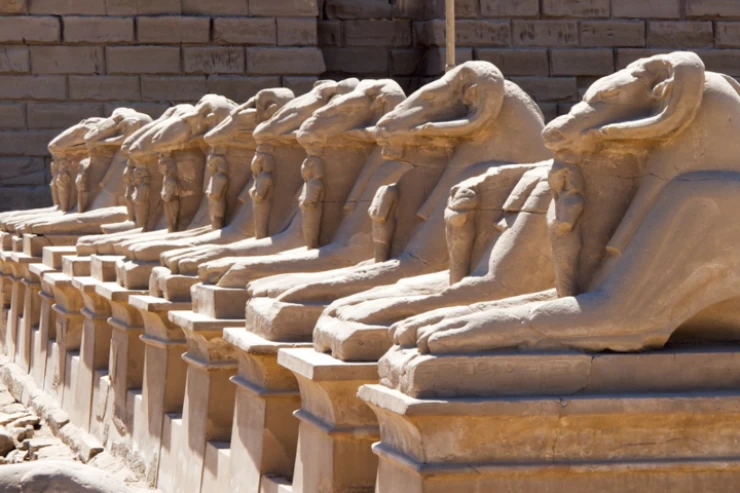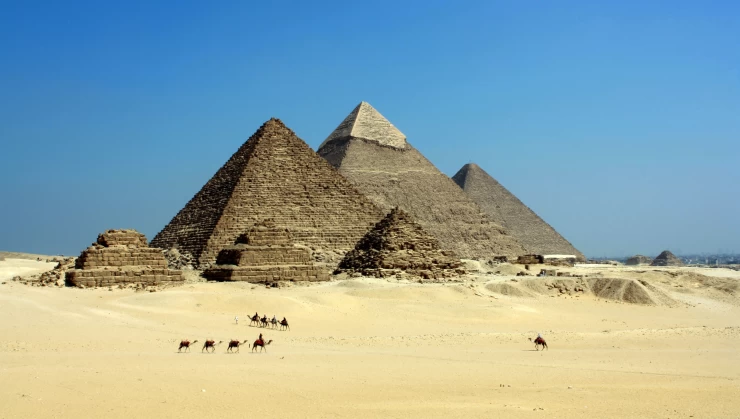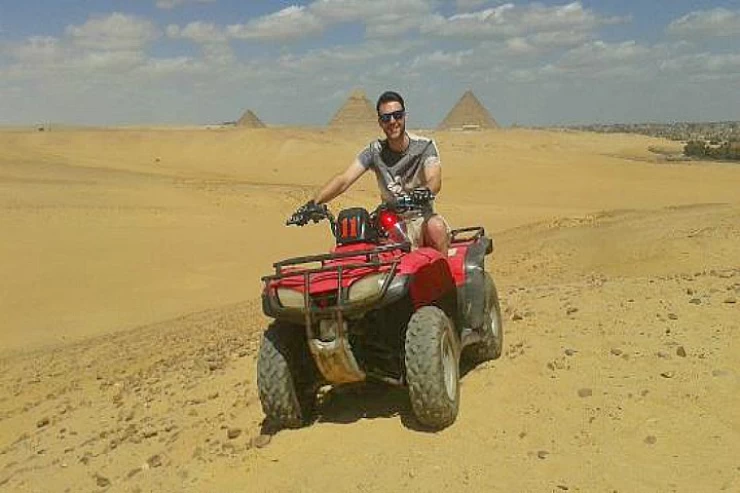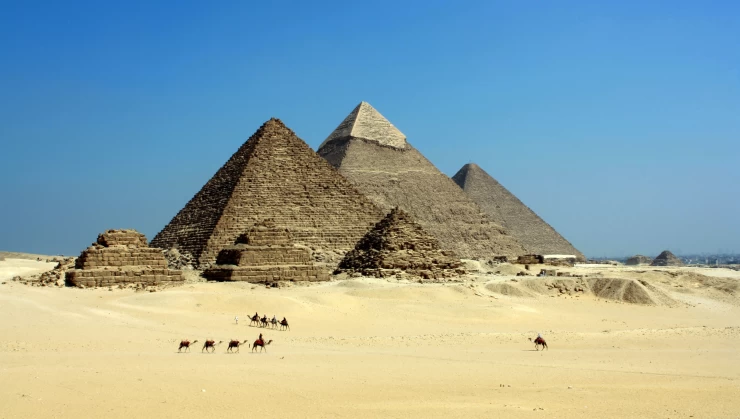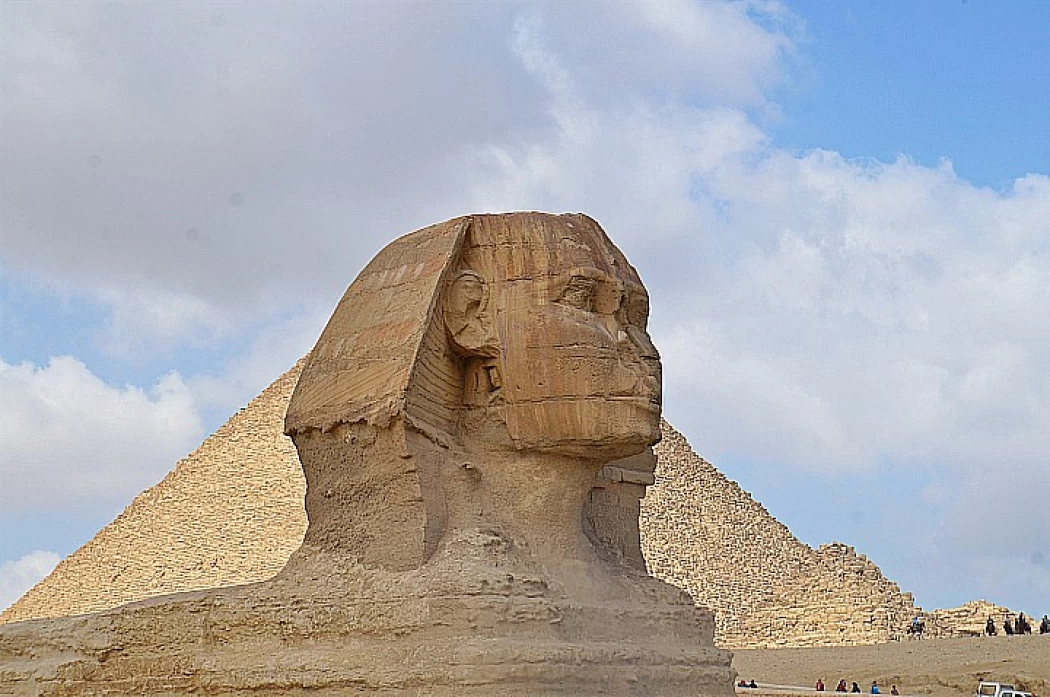
Великий сфинкс в Гизе
Великий сфинкс в Гизе.

Великий Сфинкс на плато Гизы, безусловно, является одним из самых ярких впечатлений от посещения Каира. Он расположен перед пирамидами Гизы более 4 500 лет назад приблизительно. Сфинкс считается известняковой статуей, расположенной возле Великой пирамиды в Гизе, Египет. Сфинкс имеет длину 240 футов (73 метра) и высоту 66 футов (20 метров), что делает его достаточно огромным, чтобы его можно было увидеть за много миль, а также является одной из самых узнаваемых реликвий древних египтян, хотя происхождение и история этой колоссальной статуи до сих пор обсуждаются.
Хотя нет современных свидетельств, позволяющих с уверенностью указать, кого он изображает, Стела снов, созданная фараоном Тутмосом IV в Новом царстве, ассоциирует Сфинкса с царем Хефреном. Сфинкс - это мифологическое существо, представленное в древнеегипетской культуре, которое на протяжении истории человечества приобрело различные значения. Различные культуры использовали концепцию сфинкса для обогащения своей мифологии, обеспечения символических ролей в своих храмах, а также для описания аспектов личности человека.
Великого сфинкса всегда посещают во время большинства туров в Египет и туристических пакетов в Египет, особенно однодневных туров в Каир из аэропорта, поскольку это самая древняя монументальная фигура в Египте. Обычно считается, что он был построен древними египтянами Старого царства во время правления фараона Хафре (2558 - 2532 гг. до н.э.) из Четвертой династии, владельца средней Великой пирамиды на плато Гиза.
В Древнем Египте Сфинкс (существо с телом животного и головой человека) был духовным стражем, изображаемым в виде мужчины с фараонским головным убором, как у Великого Сфинкса и фигур существ, которые были встроены в гробницы и храмовые комплексы, такие как Долина Сфинксов, соединяющая Карнакский и Луксорский храмы. Во время однодневных туров по Египту вы узнаете, что у Сфинкса под ухом проходит туннель, соединяющий его с Великой пирамидой Хуфу.
У женщины-фараона Хатшепсут также есть сфинксы. Например, гранитная статуя сфинкса в музее Метрополитен в Нью-Йорке и большой алебастровый сфинкс, расположенный в храме Рамессида в Мемфисе, Египет.
На лице отсутствует нос шириной в один метр. Исследование лица сфинкса показывает, что длинные стержни или инструменты былипомещены в нос, один из них внизу от переносицы и другой под ноздрей, а затем использовались чтобы сломать нос. Марк Лехнер, проводивший археологическое исследование, пришел к выводу, что он был разбит инструментами в неизвестное время между III и X веками.
Слово сфинкс происходит из (греческой мифологии) примерно через 2000 лет после установки статуи, что делает загадкой, как египтяне называли (Великого сфинкса) в период его расцвета.
Розовая гранитная плита между лапами Великого Сфинкса рассказывает историю о принце Тутмосе, сыне Аменхотепа II, когда он заснул возле Сфинкса и увидел сон, что Сфинкс сделает его фараоном, если он поможет ему очистить его от песка.
В начале 1800-х годов авантюрист по имени капитан Джованни Баттиста Кавилья попытался откопать статую с командой из 160 человек, поскольку Сфинкс был засыпан песком по самые плечи. В конце 1930-х годов египетский археолог Селим Хассан смог наконец освободить существо из песчаной гробницы.
Считается, что Сфинкс был центром поклонения солнцу в раннединастический период, до того как плато Гиза стало некрополем в эпоху Старого царства.
Египет встретит вас своим могучим Нилом вдоль долины Нила, когда вы будете исследовать Луксор на восточном и западном берегу. Большинство посетителей направляются прямо к самой известной достопримечательности - Великой пирамиде Хуфу, искатели приключений, путешественники и блоггеры могут присоединиться к одному из наших бюджетных туров по Египту, проходящему через пустыню Сахара, например, туры в Сиву из Каира или, предпочтительно, туры в Белую пустыню Египта.

Во время целого ряда однодневных туров в Египет вы получите возможность увидеть эту гигантскую скульптуру с телом льва, склонившуюся в пустыне на протяжении 45 веков, наблюдая за многими народами и разнообразием культур от древних египтян до греков и римлян, от французов и британцев до солдат мировой войны, которые в конце концов совершили поход под его подбородком, и им удалось найти его, погребенное под песком пустыни Гиза. Сфотографируйтесь, целуя Сфинкса, или попытайтесь надеть на его лицо солнечные очки с гидами Cairo Top Tours во время многих наших туров по Каиру и Египту:
- 2-х дневные экскурсии в Каир и Александрию из порта Александрии.
- Однодневная экскурсия к пирамидам и по Нилу.
- Экскурсионные туры на берегу Александрии.
- 2-х дневная экскурсия в Каир из Александрии. Хотя он вместе с вами определит ваш маршрут по разным местам Каира в частности и Египта в целом.
Если вы хотите узнать о городе Гиза и увидеть, как он выглядит, то на сайте, который называется Sannur Valley Cave Protectorate | Beni Suef, вы найдете много информации и фотографий. На нем вы узнаете больше о Гизе и о том, что там происходило давным-давно.
Undeniably among the most mysterious yet recognizable structures across the globe is the Great Sphinx of Giza. The Sphinx is located on the Giza Plateau near Cairo, from where it is also accessed. This sphinx is a huge statue sculptured from limestone and takes on the form of a lion with a human head believed to be that of Pharao Khafre. This captivating structure has been a topic of interest for many historians and archaeologists, including tourists, for many years, as its structure is enveloped with mystery and ancient wisdom.
The Genesis and Building of the Great Sphinx
The Great Sphinx was constructed by Pharaoh Khafre around 2500 B.C., making it one of the oldest monumental edifices in Egypt. It is formed from a single mass of limestone bedrock protruding from the Giza Plateau and carved intricately out of it. Twenty meters (66 feet) tall and 73 meters (240 feet) long, the Sphinx was probably built as a symbolic sentry to the nearby pyramids in which the pharaoh was entombed.
The structure and location of the Sphinx remain controversial, as some believe it is a standalone monument, and many other wannabe temples and causeways leading to the Pyramid of Khafre existed. Further explanation to support this theory suggests that the construction of the Sphinx took the toil of a great number of laborers armed only with copper chisels that were very crude. While it may be corniced and age-worn, this edifice stands proud as an accomplishment of the ancients.
Decoding the Sphinx: Symbolism and Significance
The Sphinx is mainly considered representative of the two vital qualities of the pharaoh, i.e., his intelligence and strength, by combining the man and a lion figure. The sphinx head bearing the same royal headdress as the pharaoh in question probably represents the more realistic likeness of the pharaoh Khafre, whose power and divine connection we'll see through this image. According to some Egyptian mythological accounts, lions served as protectors, particularly over sacred areas; in this sense, the lion body of the sphinx reiterates its function of guarding the king's burial ground.
The Sphinx in particular has changed over the years in the way that it typifies things. Some researchers believe that it could depict the sun god Ra, who held a fundamental position in the hierarchy of Egyptian beliefs and ideologies. The Sphinx has a direct pose towards the east, which happens to be the direction of the sunrise, which could add some credence to this assumption since Ra was depicted as the god who rode across the sky in a boat each day.
The Great Pyramid has its enigma
A century of theories and the Sphinx is still an enigma. One of the most conventional inquiries is: who constructed the Sphinx for what purpose? Almost all historians agree that it was built by Pharaoh Khafre. Some other theories, on the contrary, argue that the Sphinx was constructed in very remote times, perhaps even before the pyramids.
Also, some myths and beliefs about secret rooms or caves under the Sphinx remain largely unexamined. Many think that these lost spaces, if any, may house ancient scrolls or other historical items that may help in understanding some forgotten histories of Egypt. Lately, breakthroughs in ground-penetrating radar and similar technologies have tried addressing these, but so far nothing conclusive has been found.
Yet another unsolved puzzle relates to the Sphinx’s nose, which has not been seen for ages. Many speculations have been offered on its fate, including one that says it was blown off by the cannon of Napoleon’s soldiers and another that claims the Mamluks simply used it as a practice dummy. Yet there are existing records and drawings from before the era of Napoleon, which clearly show the Sphinx from the front and without the nose, suggesting that the damage had likely taken place far before that.
The Sphinx and modern restoration efforts
Through the ages, the Great Pyramid has been eroded, vandalized, and polluted, which has brought about many campaigns aimed at restoration. The Sphinx was first recorded to be attempted to be restored by Pharaoh Thutmose IV, where it was noted that he dreamt of the Sphinx informing him that he would be the king if he got rid of the sand that had covered its lower portions. Thutmose IV later erected a slab known as the Dream Stele to document this incident, which was placed in between the Sphinx’s feet.
In recent years, measures to protect the structure have involved both containment of its damage in terms of its erosion and adding extra support to the stone structure. However, in recent years, the projects have shifted focus to addressing the degradation caused by water penetration and pollution from the city of Cairo. Such measures are still active as conservationists and archaeologists try to find better ways of ensuring this ancient wonder's protection for the coming civilization.
The Great Sphinx’s visitation is something that is difficult to put into words. It can be found next to the Giza Pyramids, which makes logistics simple, and it is also common in tours around the historical sites in Cairo. As they stand next to the Sphinx, one can hardly escape the large scale of the ancient sculpture that exists in detail. The scenery outside the Sphinx also offers captivating views of the pyramids, making it a perfect place for people interested in capturing the moments in history with a camera.
The Sphinx, as one of the world’s most recognizable structures, records millions of visitors every year who can’t wait to look at its calm and enigmatic face. From dawn till dusk, the Sphinx exerts itself over the Giza Plateau, a sculpture chronicling the civilization of ancient Egypt.
The Great Sphinx in Popular Culture
Popular culture has made the sphinx an icon. Literature, film, and art have all featured the sphinx. Many works have been influenced and inspired by them, starting from ancient Greek poetry and ending in films today. Various cultures have also embraced the Sphinx Monster, who protects and asks challenging questions.
Therefore, fitting within the categories of significance and importance, the Great Sphinx of Giza has remained a fascinating emblem associated with the history of Egypt. There continue to be various explanations offered regarding its construction, significance, and symbolism. The Sphinx is forever a sentinel of the sands, a remnant of the long-gone age whose civilization thrived along the banks of the Nile River. Going to the Sphinx is not simply going to see an ancient site; it is going to confront the most mysterious and inexplicable issues that have beset mankind since time immemorial.Decoding the Sphinx:







